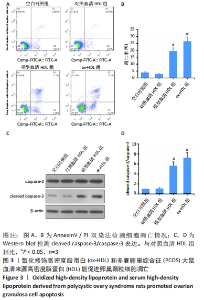Chinese Journal of Tissue Engineering Research ›› 2024, Vol. 28 ›› Issue (19): 3055-3060.doi: 10.12307/2024.168
Previous Articles Next Articles
Oxidized high-density lipoprotein promotes rat ovarian granulosa cell apoptosis through reactive oxygen species-initiated p38 signaling pathway
Guo Qin, Wu Minmin, Tao Ying
- Department of Obstetrics and Gynecology, The First Affiliated Hospital/The First Clinical Medicine School of Guangdong Pharmaceutical University, Guangzhou 510080, Guangdong Province, China
-
Received:2023-03-25Accepted:2023-06-01Online:2024-07-08Published:2023-09-26 -
Contact:Tao Ying, Master, Chief physician, Department of Obstetrics and Gynecology, The First Affiliated Hospital/The First Clinical Medicine School of Guangdong Pharmaceutical University, Guangzhou 510080, Guangdong Province, China -
About author:Guo Qin, Master, Associate chief physician, Department of Obstetrics and Gynecology, The First Affiliated Hospital/The First Clinical Medicine School of Guangdong Pharmaceutical University, Guangzhou 510080, Guangdong Province, China -
Supported by:Guangdong Medical Science and Technology Research Fund Project, No. A2019364 (to GQ)
CLC Number:
Cite this article
Guo Qin, Wu Minmin, Tao Ying. Oxidized high-density lipoprotein promotes rat ovarian granulosa cell apoptosis through reactive oxygen species-initiated p38 signaling pathway[J]. Chinese Journal of Tissue Engineering Research, 2024, 28(19): 3055-3060.
share this article
Add to citation manager EndNote|Reference Manager|ProCite|BibTeX|RefWorks
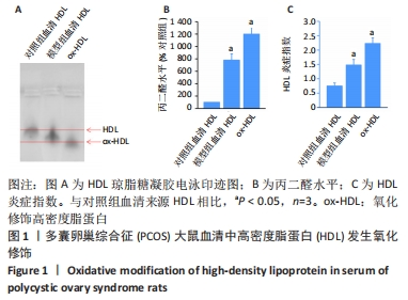
2.1 PCOS大鼠血清中部分HDL发生氧化修饰 为验证PCOS大鼠血清中HDL是否发生氧化修饰,采用差速离心分离血清中HDL,然后用HDL琼脂糖凝胶电泳检测迁移印迹,实验发现模型组大鼠血清HDL在HDL和ox-HDL 2个迁移部位均有印迹,提示PCOS大鼠血清中的部分HDL发生氧化修饰,见图1A。用丙二醛活性试剂盒检测对照组和模型组大鼠血清中HDL的氧化程度,结果见图1B,与对照组相比,模型组血清来源HDL的丙二醛活性明显增高(P < 0.05),但低于阳性对照ox-HDL的丙二醛活性(P < 0.05),说明PCOS大鼠血清中的部分HDL发生氧化修饰。HDL炎症指数检测结果显示,对照组血清来源HDL、模型组血清来源HDL和阳性对照ox-HDL的HDL炎症指数分别为0.78±0.08,1.46±0.18和2.32±0.15,见图1C,说明PCOS大鼠血清中的HDL炎症指数> 1,代表PCOS大鼠血清中HDL发生氧化修饰。"
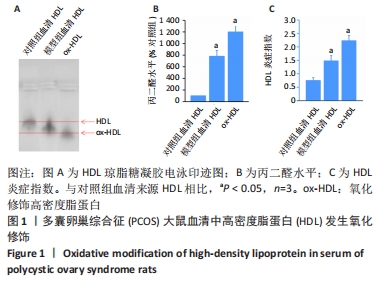
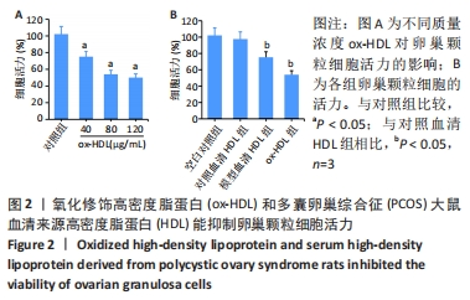
2.2 ox-HDL以及PCOS大鼠血清来源HDL对卵巢颗粒细胞活力的影响 为验证ox-HDL是否对卵巢颗粒细胞活力产生影响,首先采用CCK-8法确定ox-HDL对卵巢颗粒细胞活力影响,见图2A,卵巢颗粒细胞经不同质量浓度的ox-HDL处理24 h后,细胞活力随ox-HDL质量浓度的增加而降低(P < 0.05),其中80,120 μg/mL ox-HDL均能显著抑制细胞活力,且二者抑制效果相比无统计学差异,选择终质量浓度为80 μg/mL的 ox-HDL作为后续实验条件。进一步检测80 μg/mL对照组血清来源HDL、模型组血清来源HDL以及阳性对照ox-HDL对卵巢颗粒细胞活力的影响,发现模型组血清来源HDL和ox-HDL能抑制细胞活力(P < 0.05),见图2B。"

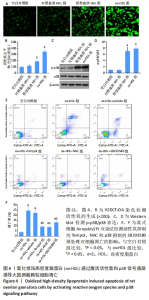
2.4 ox-HDL以及PCOS大鼠血清来源HDL对大鼠卵巢颗粒细胞活性氧生成和p38信号活性的影响 为研究对照组血清来源HDL、模型组血清来源HDL以及阳性对照ox-HDL对活性氧生成和p38信号通路影响,实验选择超氧化物染料探针H2DCF-DA检测活性氧的生成以及Western blot检测总p38和p-p38的表达,见图4A-D。相对于空白对照组,对照组血清来源HDL不影响活性氧生成以及总p38及p-p38表达,而模型组血清来源HDL和阳性对照ox-HDL均能促进活性氧生成和p-p38表达(P < 0.05),但不影响总p38表达。为进一步明确ox-HDL通过活性氧和p38通路激活来诱导卵巢颗粒细胞凋亡,采用活性氧抑制剂Tempol、NAC或p-p38抑制剂SB203580分别预孵育卵巢颗粒细胞30 min,然后与ox-HDL共孵育24 h,采用流式细胞AnnexinV/PI 双染法检测细胞凋亡,见图4E,F,结果显示活性氧抑制剂Tempol、NAC或p-p38 抑制剂SB203580均能部分逆转ox-HDL诱导的卵巢颗粒细胞凋亡(P < 0.05)。"

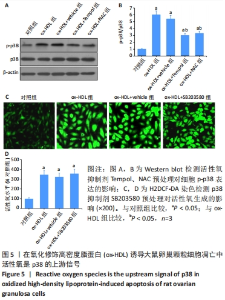
2.5 活性氧激活信号在ox-HDL诱导大鼠卵巢颗粒细胞凋亡中是p38上游信号通路 为验证在ox-HDL诱导大鼠卵巢颗粒细胞凋亡实验中活性氧信号的激活是否早于p38信号激活,实验选择活性氧抑制剂Tempol、NAC预孵育大鼠卵巢颗粒细胞30 min,然后与ox-HDL共孵育24 h,Western blot检测p-p38的表达,见图5A,B,结果显示,活性氧抑制剂Tempol、NAC均能显著抑制ox-HDL诱导的大鼠卵巢颗粒细胞p-p38表达(P < 0.05),不影响总p38表达。而选择p-p38抑制剂SB203580预孵育大鼠卵巢颗粒细胞30 min,然后与ox-HDL共孵育24 h,H2DCF-DA染色检测活性氧的生成,发现p-p38抑制剂SB203580并不能影响ox-HDL诱导的大鼠卵巢颗粒细胞活性氧生成,见图5C,D。以上结果提示,在ox-HDL诱导大鼠卵巢颗粒细胞凋亡实验中,活性氧是p38的上游信号。"

| [1] PALOMBA S, PILTONEN TT, GIUDICE LC. Endometrial function in women with polycystic ovary syndrome: a comprehensive review. Hum Reprod Update. 2021;27(3):584-618. [2] JOHAM AE, NORMAN RJ, STENER-VICTORIN E, et al. Polycystic ovary syndrome. Lancet Diabetes Endocrinol. 2022;10(9):668-680. [3] SADEGHI HM, ADELI I, CALINA D, et al. Polycystic Ovary Syndrome: A Comprehensive Review of Pathogenesis, Management, and Drug Repurposing. Int J Mol Sci. 2022;23(2):583. [4] HUDDLESTON HG, DOKRAS A. Diagnosis and Treatment of Polycystic Ovary Syndrome. JAMA. 2022;327(3):274-275. [5] PATEL S. Polycystic ovary syndrome (PCOS), an inflammatory, systemic, lifestyle endocrinopathy. J Steroid Biochem Mol Biol. 2018;182:27-36. [6] MOUSA A, JOHAM A, BOYLE J. Polycystic Ovary Syndrome. Semin Reprod Med. 2021;39(3-04):69-70. [7] ZHONG P, GUAN B, LIN Y, et al. Changes in inflammatory factors, oxidative stress, glucose and lipid metabolism, and insulin resistance in patients with polycystic ovary syndrome. Cell Mol Biol (Noisy-le-grand). 2022;67(5):45-50. [8] PEROVIC BLAGOJEVIC IM, VEKIC JZ, MACUT DP, et al. Overweight and obesity in polycystic ovary syndrome: association with inflammation, oxidative stress and dyslipidaemia. Br J Nutr. 2022;128(4):604-612. [9] ZHANG J, ZHANG Y, LIU H, et al. Antioxidant properties of high-density lipoproteins are impaired in women with polycystic ovary syndrome. Fertil Steril. 2015;103(5):1346-1354. [10] 郭琴,骆婕,廖凤儿,等.FBW7通过促进NOX1降解抑制ox-LDL诱导的颗粒细胞凋亡[J].中国病理生理杂志,2020,36(12):2234-2243. [11] WANG L, LI H, TANG X, et al. Oxidized high-density lipoprotein enhances endocrine disorders and ovarian damage in rats. J Cell Mol Med. 2021;25(17):8115-8126. [12] IBRAHIM YF, ALORABI M, ABDELZAHER WY, et al. Diacerein ameliorates letrozole-induced polycystic ovarian syndrome in rats. Biomed Pharmacother. 2022;149:112870. [13] PETERS CN, EVANS IE. Automated Processing of Plasma Samples for Lipoprotein Separation by Rate-Zonal Ultracentrifugation. J Lab Autom. 2016;21(6):756-764. [14] PIOMBONI P, FOCARELLI R, CAPALDO A, et al. Protein modification as oxidative stress marker in follicular fluid from women with polycystic ovary syndrome: the effect of inositol and metformin. J Assist Reprod Genet. 2014;31(10):1269-1276. [15] GONG Y, LUO S, FAN P, et al. Growth hormone activates PI3K/Akt signaling and inhibits ROS accumulation and apoptosis in granulosa cells of patients with polycystic ovary syndrome. Reprod Biol Endocrinol. 2020;18(1):121. [16] CAO J, HUO P, CUI K, et al. Follicular fluid-derived exosomal miR-143-3p/miR-155-5p regulate follicular dysplasia by modulating glycolysis in granulosa cells in polycystic ovary syndrome. Cell Commun Signal. 2022;20(1):61. [17] MOHAMMADI M. Oxidative Stress and Polycystic Ovary Syndrome: A Brief Review. Int J Prev Med. 2019;10:86. [18] ZHANG Q, REN J, WANG F, et al. Mitochondrial and glucose metabolic dysfunctions in granulosa cells induce impaired oocytes of polycystic ovary syndrome through Sirtuin 3. Free Radic Biol Med. 2022;187:1-16. [19] TAN W, DAI F, YANG D, et al. MiR-93-5p promotes granulosa cell apoptosis and ferroptosis by the NF-kB signaling pathway in polycystic ovary syndrome. Front Immunol. 2022;13:967151. [20] SOLEK P, MAJCHROWICZ L, KOZIOROWSKI M. Aloe arborescens juice prevents EMF-induced oxidative stress and thus protects from pathophysiology in the male reproductive system in vitro. Environ Res. 2018;166:141-149. [21] SUN J, GUO Y, FAN Y, et al. Decreased expression of IDH1 by chronic unpredictable stress suppresses proliferation and accelerates senescence of granulosa cells through ROS activated MAPK signaling pathways. Free Radic Biol Med. 2021;169:122-136. [22] AN R, WANG X, YANG L, et al. Polystyrene microplastics cause granulosa cells apoptosis and fibrosis in ovary through oxidative stress in rats. Toxicology. 2021;449:152665. [23] ZHOU XY, ZHANG J, LI Y, et al. Advanced Oxidation Protein Products Induce G1/G0-Phase Arrest in Ovarian Granulosa Cells via the ROS-JNK/p38 MAPK-p21 Pathway in Premature Ovarian Insufficiency. Oxid Med Cell Longev. 2021;2021:6634718. [24] WANG M, LI Y, GAO Y, et al. Vitamin E regulates bovine granulosa cell apoptosis via NRF2-mediated defence mechanism by activating PI3K/AKT and ERK1/2 signalling pathways. Reprod Domest Anim. 2021;56(8):1066-1084. [25] 傅明德.人血浆高密度脂蛋白亚类分布与动脉粥样硬化[J].中国动脉硬化杂志,2012,20(10):865-870. [26] DENG S, XU Y, ZHENG L. HDL Structure. Adv Exp Med Biol. 2022;1377: 1-11. [27] WANG Y, LIU H, FAN P, et al. Evidence for association between paraoxonase 1 gene polymorphisms and polycystic ovarian syndrome in southwest Chinese women. Eur J Endocrinol. 2012;166(5):877-885. [28] DEAKIN S, MOREN X, JAMES RW. HDL oxidation compromises its influence on paraoxonase-1 secretion and its capacity to modulate enzyme activity. Arterioscler Thromb Vasc Biol. 2007;27(5):1146-1152. [29] FAN P, LIU HW, WAN DH, et al. Altered distribution of plasma platelet-activating factor acetylhydrolase between high-density lipoprotein and low-density lipoprotein in patients with polycystic ovary syndrome. Fertil Steril. 2009;92(6):2054-2057. [30] ZHANG Q, JIANG Z, XU Y. HDL and Oxidation. Adv Exp Med Biol. 2022; 1377:63-77. [31] GAO D, ASHRAF MZ, ZHANG L, et al. Cross-linking modifications of HDL apoproteins by oxidized phospholipids: structural characterization, in vivo detection, and functional implications. J Biol Chem. 2020;295(7): 1973-1984. |
| [1] | Yang Yifeng, Ye Nan, Wang Lin, Guo Shuaicheng, Huang Jian. Signaling pathway of dexmedetomidine against ischemia-reperfusion injury [J]. Chinese Journal of Tissue Engineering Research, 2024, 28(9): 1464-1469. |
| [2] | Huang Haoran, Fan Yinuo, Wei-Yang Wenxiang, Jiang Mengyu, Fang Hanjun, Wang Haibin, Chen Zhenqiu, Liu Yuhao, Zhou Chi. Urolithin A mediates p38/MAPK pathway to inhibit osteoclast activity [J]. Chinese Journal of Tissue Engineering Research, 2024, 28(8): 1149-1154. |
| [3] | Yue Yun, Wang Peipei, Yuan Zhaohe, He Shengcun, Jia Xusheng, Liu Qian, Li Zhantao, Fu Huiling, Song Fei, Jia Menghui. Effects of croton cream on JNK/p38 MAPK signaling pathway and neuronal apoptosis in cerebral ischemia-reperfusion injury rats [J]. Chinese Journal of Tissue Engineering Research, 2024, 28(8): 1186-1192. |
| [4] | Liu Qiwei, Zhang Junhui, Yang Yuan, Wang Jinjuan. Role and mechanism of umbilical cord mesenchymal stem cells on polycystic ovary syndrome [J]. Chinese Journal of Tissue Engineering Research, 2024, 28(7): 1015-1020. |
| [5] | Shen Feiyan, Yao Jixiang, Su Shanshan, Zhao Zhongmin, Tang Weidong. Knockdown of circRNA WD repeat containing protein 1 inhibits proliferation and induces apoptosis of chondrocytes in knee osteoarthritis [J]. Chinese Journal of Tissue Engineering Research, 2024, 28(4): 499-504. |
| [6] | Chen Zepeng, Hou Yonghui, Chen Shudong, Hou Yu, Lin Dingkun. Tauroursodeoxycholic acid treats spinal cord injury by reducing apoptosis of spinal cord neurons under glucose and oxygen deprivation [J]. Chinese Journal of Tissue Engineering Research, 2024, 28(4): 528-534. |
| [7] | Xie Ting, Liu Tingting, Zeng Xuehui, Li Yamin, Zhou Panghu, Yi Nianhua. Fucoxanthin alleviates glucocorticoid-induced osteoblast apoptosis by activating nuclear factor erythroid-2-related factor 2 [J]. Chinese Journal of Tissue Engineering Research, 2024, 28(23): 3609-3614. |
| [8] | Ma Wanli, Yang Hongsheng, Qu Bo, Zhang Zhengdong, Gong Kai, Lin Yanshui. Mechanisms by which baicalein protects against steriod-induced osteonecrosis of the femoral head in rats [J]. Chinese Journal of Tissue Engineering Research, 2024, 28(23): 3661-3668. |
| [9] | Zhu Yongzhao, Fang Chao, Zhao Fang, Zhang Qing, Zhao Dan. Mechanism by which lycium barbarum polysaccharides inhibit keratinocyte apoptosis in burn wounds via autophagy [J]. Chinese Journal of Tissue Engineering Research, 2024, 28(23): 3686-3691. |
| [10] | Ning Taoli, Xie Yan, Wang Na, Wang Qingfeng, Ji Jian, Zhang Dongna. Grape seed extract inhibits apoptosis in growth plate chondrocytes and promotes tibial growth in rats [J]. Chinese Journal of Tissue Engineering Research, 2024, 28(20): 3216-3222. |
| [11] | Ran Lei, Han Haihui, Xu Bo, Wang Jianye, Shen Jun, Xiao Lianbo, Shi Qi. Molecular docking analysis of the anti-inflammatory mechanism of Cibotium barometz and Epimedium for rheumatoid arthritis: animal experiment validation [J]. Chinese Journal of Tissue Engineering Research, 2024, 28(2): 208-215. |
| [12] | Zuo Jun, Ma Shaolin. Mechanism of beta-sitosterol on hypertrophic scar fibroblasts: an analysis based on network pharmacology [J]. Chinese Journal of Tissue Engineering Research, 2024, 28(2): 216-223. |
| [13] | Wang Qian, Lu Ziang, Li Lihe, Lyu Chaoliang, Wang Meng, Zhang Cunxin. Sinomenine effectively inhibits interleukin-1beta-induced apoptosis in nucleus pulposus cells [J]. Chinese Journal of Tissue Engineering Research, 2024, 28(2): 224-230. |
| [14] | Chen Simin, Hu Yingjun, Yan Wenrui, Ji Le, Shao Mengli, Sun Ze, Zheng Hongxing, Qi Shanshan. Establishment and evaluation of a streptozotocin-induced diabetic encephalopathy rat model [J]. Chinese Journal of Tissue Engineering Research, 2024, 28(2): 237-241. |
| [15] | Long Zhisheng, Gong Feipeng, Wen Jiabin, Min Huan, Shu Yang, Lai Zhuoxi, Chen Gang. Bone marrow mesenchymal stem cell exosomes combined with epigallocatechin-3-gallate in treatment of spinal cord ischemia/reperfusion injury in rats [J]. Chinese Journal of Tissue Engineering Research, 2024, 28(19): 2953-2959. |
| Viewed | ||||||
|
Full text |
|
|||||
|
Abstract |
|
|||||
